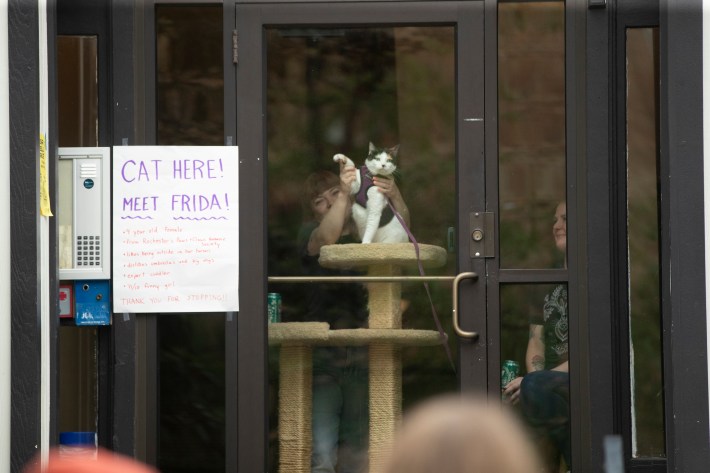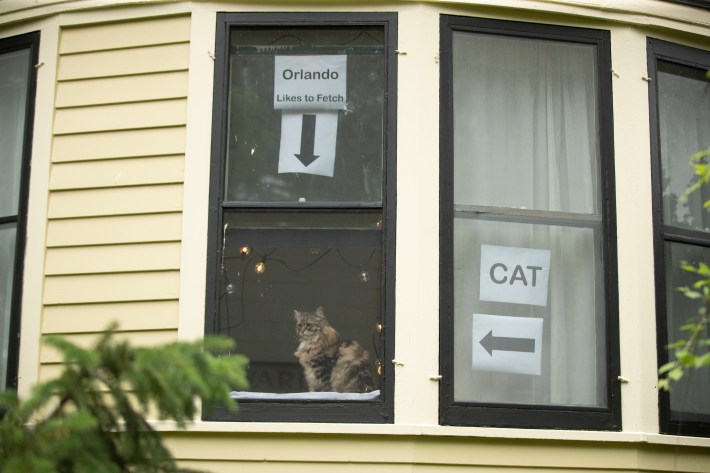For some time now, Herodotus’ Histories, in the Aubrey de
Sélincourt translation, has been my bedside book, and I just got to the
end; this is my second time through the Histories, and I
wouldn’t be surprised if I visit it again.
I think there’s lots in here for just about everybody, but anyone
who cares about history in the large would I think be mesmerised.
I’ll describe the book briefly and outline some of the reasons I like it
so much.
Also I’ll trace a line of descent into some excellent contemporary fantasy
writing, and wonder about parallels with the current Middle East imbroglio.
[Reposted for your amusement on its 20th anniversary.]
Herodotus had something of a mini-revival in the nineties, in large part
due to Michael Ondaatje’s excellent book The English Patient,
which
was made into a nice movie; the book was full of references to him.
The Book
The Histories claim right in the first paragraph to be about
the two invasions of Greece by the Persian empire, the first led by Darius and
the second by his son Xerxes; these wars included the famous battles of
Marathon (490 BCE), Thermopylae (480), and Salamis (479).
However, Herodotus has some serious fun with this; he starts at the
beginning, explaining how the Persian Empire came to be, with pretty
substantial tours through the history, customs, and legends of all the lands
and peoples that went into it; and that’s a lot of lands and
peoples.
Herodotus claims to have visited many of these places, and while later
historians have cast doubt on some of these claims, it does seem likely that
he did see something of Egypt and the lands around the Black Sea.
He’s careful in distinguishing the things he saw himself from the things
others told him, and is free with his opinions as to how much or little he
believes.
Later classic historians, starting with Thucydides (also worth reading),
are pretty tough on Herodotus, dubbing him “father of lies”, but more
recent authors have tended to be kinder.
The style, in de Sélincourt’s translation, is chatty and rambling,
which is appropriate according to commentary I’ve read from those familiar
with the old-Greek originals; the English is uninflected mid-Twentieth-century
standard.
It’s very easy reading, although one can grow weary of hearing about the
religous, farming, and sexual practices of yet another of the peoples of
Upper East Central Cilicia.
The Person
There is a “Biographical Tradition” concerning Herodotus but remarkably
little is known firmly, outside of what one can learn by reading him.
He was probably born during the progress of the war he describes; he mentions
events that took place as late as 430.
He came from Helicarnassus, a Greek city in Ionia (now Eastern Turkey);
obviously he was well-off, it is reasonable to suspect that some of his
travels were on business.
Every time I open the pages, I get a little thrill at the thought that I’m
reading words written two and a half millenia ago.
Herodotus’ life was
hugely different from mine in almost every aspect; but at another level, he’s
just this guy who wrote good stuff and whom I feel I know, as a person,
rather well; I’ll never have the chance to sit down and share a cup of wine
with him, but if I did, I bet we’d hit it right off.
The Tourism
Many complain about Herodotus’ endless travel-guide side-trips, and maybe
they have a point, but some of them are awfully compelling.
Here is his description of “A labyrinth a little above Lake Moeris, near
the
place called the City of Crocodiles”; this is in Egypt.
I have seen this building, and it is beyond my power to describe;
it must have cost more in labour and money than all the walls and public
works of the Greeks put together - though no one would deny that the temples
at Ephesus and Samos are remarkable buildings. The pyramids, too, are
astonishing structures, each one them equal to many of the most ambitious
works of Greece; but the labyrinth surpasses them. It has twelve covered
courts - six in a row facing north, six south - the gates of the one range
exactly fronting the gates of the other. Inside, the building is of two
storeys and contains three thousand rooms, of which half are underground, and
the other half directly above them. I was taken through the rooms in the
upper storey, so what I shall say of them is from my own observation, but the
underground ones I can speak of only from report, because the Egyptians in
charge refused to let me see them, as they contain the tombs of the kings who
built the labyrinth, and also the tombs of the sacred crocodiles. The upper
rooms, on the contrary, I did actually see, and it is hard to believe that
they are the work of men; the baffling and intricate passages from room to
room and from court to court were and endless wonder to me, as we passed from
a courtyard into rooms, from rooms into galleries, from galleries into more
rooms and thence into yet more courtyards. The roof of every chamber,
courtyard, and gallery is, like the walls, of stone. The walls are are
covered with carved figures, and each court is exquisitely built of white
marble and surrounded by a colonnade. Near the corner where the labyrinth
ends there is a pyramid, two hundred and forty feet in height, with great
carved figures of animals on it and an underground passage by which it can be
entered. Marvellous as the labyrinth is the so-called Lake of Moeris beside
which it stands is perhaps even more astonishing ... this immense basin is
obviously artificial, for nearly in the middle of it are two pyramids,
standing three hundred feet out of the water (with their bases an equal depth
below the surface) and each surmounted by the stone image of a man sitting on
a throne.
I’m saddened that I’ll never get to visit.
His descriptions of things that still stand, for example the Pyramids, is
vivid too; they were a lot prettier 2,400 years ago.
The War
I am not a historian and have been telling myself for years that I really
ought to get a good competent modern scholarly history of this war and see
what I learn - I did study it in college but that’s a long time ago, so
my take is heavily influenced by Herodotus’.
The Persian empire was a fairly recent arrival at this time; it grew
astonishingly fast, and the Persians were the superpower of their time as
America is of ours.
Thus, their failure to overrun Greece is surprising.
The numbers that Herodotus bandies about - in excess of 2½; million in
Xerxes’ invasion force - are hard to believe, but pretty clearly it was a big
army.
The conventional wisdom is that the Greeks - in particular the Athenians -
had dramatically superior maritime/naval skills, and that in close combat the
more heavily armed and amored Greek phalanx could handle substantially larger
numbers of the more lightly-armed Persians.
The Greek generalship seems to have been good at the battle of Marathon and
the less-known but crucial battle of Plataea, but doesn’t seem to have been
that much of a factor elsewhere.
It’s also worth noting that a substantial proportion of the Greek city-states
had (some voluntarily) signed up with the Persians, so there were Greeks on
both sides in these battles.
Herodotus’ take seems pretty fair - while he is pro-Greek, he quick to
praise particularly brave, wise, or honourable Persians.
Likewise, he is ruthless in his description of the backbiting, bribery, and
treachery that dominated the relationships between the Greek cities; so much
so as to increase one’s wonder that they managed to win this war.
One is left far from impressed with some of the famous Greek personages whom
you may remember from your history books.
On the other hand, the Greeks are consistent in pointing out that they are
fighting for freedom and (a then-new idea) democracy, and against a foreign
invader; these are all advantages.
Herodotus had a hometown-boy penchant for talking up the achievements of
the Halicarnassians; this is pleasant in that we get the spotlight on one
Artimesia, their queen, fighting for the Persians at Salamis, the only
female commander (says Herodotus) there,
and by his account a dashing figure.
Pursued by a larger Greek ship, she adopted the strategy of ramming and
sinking the nearest Persian ship; the Greek decided she must be a friend and
abandoned the pursuit, while Xerxes, sitting on the hillside watching the
battle, exclaimed “Today my men turn to women and my women to
men!”;
And, Herodotus remarks conversationally, “She was lucky in every way -
not least in the fact that there were no survivors from the Calyndian ship
[that she rammed] to
accuse her.”; Hmm.
Of course the most famous of all these battles was at Thermopylae, where
Leonidas and his 300 Spartans held up the entire Persian army for days by
defending a narrow defile and being perfectly willing to die rather than be
moved.
After the war the Greeks erected a monument, now gone, with an inscription
that de Sélincourt translates:
Go tell the Spartans, you who read
We took their orders, and are dead.
But there are other translations; I like
Go stranger, and to Sparta tell:
Here, faithful to its law, we fell.
Parallels With Current Events?
It is tempting to draw a parallel between the events of BCE 479 and those
of 2003; after all, here we have the world’s pre-eminent power engaging in
two wars against a much smaller one, the first led by a father and the second
by a son, at an interval of about ten years.
But I don’t think there’s any mileage there;
nobody thinks the Iraqis have superior military technology, and nobody is
expecting the equivalent of a Thermopylae.
On the other hand, Herodotus’ account of the treacherous butchery by which
Darius came to occupy the throne of Persia and pass it on to his son Xerxes is
quite reminiscent of Republican party politics.
And there’s a lesson to be learned from Leonidas: when you have a smart
and determined enemy who’s willing to die to hurt you, you’re usually going
to get hurt. For a contemporary example consider 9/11.
Gene Wolfe Takes up Herodotus’ Torch
Gene Wolfe, for my money the greatest living writer of sci-fi, fantasy,
and lots of other stuff too, published two books in the Eighties,
Soldier of the Mist and Soldier of Arete, the first
dedicated to Herodotus and both set in the period immediately following the
failure of Xerxes’ invasion.
They feature many of the personages who appear in Herodotus’ narrative, and
are gripping, deep, and magical.
Furthermore Wolfe, unlike me, is a serious student both of military history
and of archaic theology, and you’ll learn a whole bunch about the realities
of life and war in the Classical period.
Web Resources
The Perseus project has an
astounding
online edition of the Histories, with heavily
annotated and hyperlinked texts available in English and Greek.














































